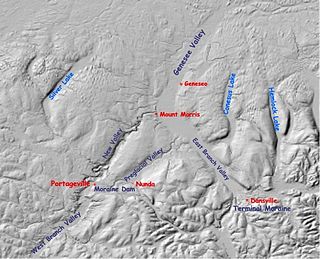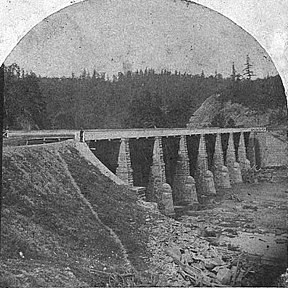
The Erie Canal is a historic canal in upstate New York that runs east–west between the Hudson River and Lake Erie. Completed in 1825, the canal was the first navigable waterway connecting the Atlantic Ocean to the Great Lakes, vastly reducing the costs of transporting people and goods across the Appalachians. In effect, the canal accelerated the settlement of the Great Lakes region, the westward expansion of the United States, and the economic ascendancy of New York State. It has been called "The Nation's First Superhighway."

The Allegheny River is a 325-mile-long (523 km) headwater stream of the Ohio River that is located in western Pennsylvania and New York in the United States. It runs from its headwaters just below the middle of Pennsylvania's northern border, northwesterly into New York, then in a zigzag southwesterly across the border and through Western Pennsylvania to join the Monongahela River at the Forks of the Ohio at Point State Park in Downtown Pittsburgh, Pennsylvania.

Cattaraugus County is a county in Western New York, with one side bordering Pennsylvania. As of the United States 2020 census, the population was 77,042. The county seat is Little Valley. The county was created in 1808 and later organized in 1817. The county is part of the Western New York region of the state.

Livingston County is a county in the U.S. state of New York. As of the 2020 census, the population was 61,834. Its county seat is Geneseo. The county is named after Robert R. Livingston, who helped draft the Declaration of Independence and negotiated the Louisiana Purchase. The county is part of the Finger Lakes region of the state.

Letchworth State Park is a 14,427-acre (5,838 ha) New York State Park located in Livingston County and Wyoming County in the western part of the State of New York. The park is roughly 17 miles (27 km) long, following the course of the Genesee River as it flows north through a deep gorge and over several large waterfalls. It is located 35 miles (56 km) southwest of Rochester and 60 miles (97 km) southeast of Buffalo, and spans portions of the Livingston County towns of Leicester, Mount Morris and Portage, as well as the Wyoming County towns of Castile and Genesee Falls.

IschuaISH-way is a town in Cattaraugus County, New York, United States. The population was 736 at the 2020 census. Ischua is also the name of a hamlet in the town. The town is on the eastern border of the county, north of Olean.

Olean is a city in Cattaraugus County, New York, United States. Olean is the largest city in Cattaraugus County and serves as its financial, business, transportation and entertainment center. It is one of the principal cities of the Southern Tier region of Western New York.
Mount Morris is a village in the town of Mount Morris in Livingston County, New York, United States. The village population was 2,986 at the 2010 census, out of 4,465 in the entire town. The village and town are named after Robert Morris.

The Genesee River is a tributary of Lake Ontario flowing northward through the Twin Tiers of Pennsylvania and New York in the United States. The river contains several waterfalls in New York at Letchworth State Park and Rochester.

The Genesee River flows northward from its source in northern Pennsylvania to enter Lake Ontario at Rochester, New York.

The Mount Morris Dam is a concrete gravity dam on the Genesee River. It is located at the northern end of Letchworth State Park, south of Rochester, New York in the towns of Leicester and Mount Morris in Livingston County, New York. It is the largest dam of its type east of the Mississippi River and its purpose is to mitigate downstream flooding between Mount Morris and Lake Ontario.

The Ohio and Erie Canal was a canal constructed during the 1820s and early 1830s in Ohio. It connected Akron with the Cuyahoga River near its outlet on Lake Erie in Cleveland, and a few years later, with the Ohio River near Portsmouth. It also had connections to other canal systems in Pennsylvania.
The Genesee Valley Canal Railroad was a part of the Pennsylvania Railroad system in western New York. It was built on the former Genesee Valley Canal alignment.

New York State Route 63 (NY 63) is a state highway in the western part of New York in the United States. It extends for 82.11 miles (132.14 km) in a generally southeast–northwest direction from an intersection with NY 15 and NY 21 in the village of Wayland in Steuben County to a junction with NY 18 in the town of Yates in Orleans County, 2 miles (3.2 km) south of the Lake Ontario shoreline. The route passes through the city of Batavia and enters or comes near several villages, including Dansville and Medina.

New York State Route 446 (NY 446) is a state highway in the Southern Tier of New York in the United States. The highway extends for 6.76 miles (10.88 km) on a northeast–southwest alignment from an intersection with NY 16 north of the hamlet of Hinsdale to a junction with NY 305 in the village of Cuba. It parallels the Southern Tier Expressway very closely for its entire length. NY 446 was originally designated as part of Route 4, an unsigned legislative route, in 1908. The Hinsdale–Cuba highway received its first posted designation in 1924 when it was included as part of NY 17. It was renumbered twice, becoming part of NY 63 in 1930 and NY 408 in the 1940s, before gaining its current designation on July 1, 1974.

The Genesee Valley Greenway is a rail trail in western New York's Genesee River valley.

The Pennsylvania Canal, sometimes known as the Pennsylvania Canal system, was a complex system of transportation infrastructure improvements, including canals, dams, locks, tow paths, aqueducts, and viaducts. The canal was constructed and assembled over several decades beginning in 1824, the year of the first enabling act and budget items.

The Beaver and Erie Canal, also known as the Erie Extension Canal, was part of the Pennsylvania Canal system and consisted of three sections: the Beaver Division, the Shenango Division, and the Conneaut Division. The canal ran 136 miles (219 km) north–south near the western edge of the state from the Ohio River to Lake Erie through Beaver County, Lawrence County, Mercer County, Crawford County, and Erie County, Pennsylvania.
The Western New York and Pennsylvania Railway was a railroad that operated in the U.S. states of New York and Pennsylvania.
Cuba Lake is a 454-acre (1.84 km2) reservoir in Allegany and Cattaraugus counties, New York.















